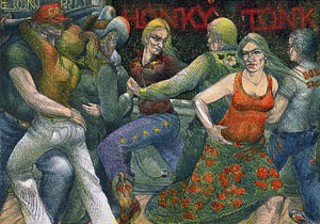Heaven
Sunday church left him cold
His soul was emptier when he left than when
he went in
No. He had no room for a God created in
Man’s image
It was an image he wanted no part of
There were better places to spend his
Sundays
Enveloped by the Origin of the World was
one holy place
Where his essence was in rhythm with the
living breathing
Of the honky-tonk queen Betty Jean
He sang out to Heaven

Honky Tonk -- Luis Jiménez
In 1866 Gustave Courbet pained "L'Origine du monde ("The Origin of the World"), a close-up view of the genitals and abdomen of a naked woman lying on a bed with legs spread. The faceless model was probably Joanna Hiffernan, the lover of Courbet's friend and protege, the American painter James Abbott McNeill Whistler. The work was commissioned by the Turkish diplomat Khalil Bey, who already owned Courbet's "Le Sommeil" (The Sleepers) depicting a nude Hiffernan in a lesbian embrace; her appearance in the two notorious paintings was probably the reason for the brutal separation of the two artists shortly afterwards. After the diplomat's financial ruin due to his gambling, in passed through various hands. Hungarian collector baron Hatvany Ferenc bought it in 1910 and took it with him to Budapest; during World War II he ransomed it after it was looted by Soviet troops. When he emigrated to France in 1947 he was only allowed to take one piece of art with him, so "L'Origine du monde" finally returned to Paris. In 1955 it was bought at auction by Jacques Lacan for 1.5 million francs (about $4,000). Neither painting was publicly exhibited until 1988, as part of a Courbet retrospective held by the Metropolitan Museum of Art in New York. The following year ORBAN created a cibachrome(a dye destruction positive-to-positive photographic process used for the reproduction of film transparencies on photographic paper) called "L'origine de la guerre" (The Origin of War), that featured an erect penis. Committed to painting only what he could see, Courbet was the leader of the French Realists. He was imprisoned for 6 months in 1871 due to his involvement with the radical Paris Commune during the Franco-Prussian War, and lived in exile in Switzerland from 1873 until his death 4 years later. As he explained, "I have always lived in freedom; let me end my life free; when I am dead let this be said of me: 'He belonged to no school, to no church, to no institution, to no academy, least of all to any régime except the régime of liberty.'"
ReplyDelete